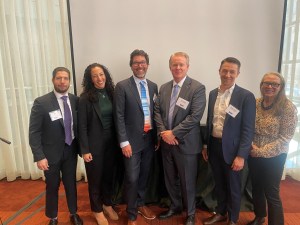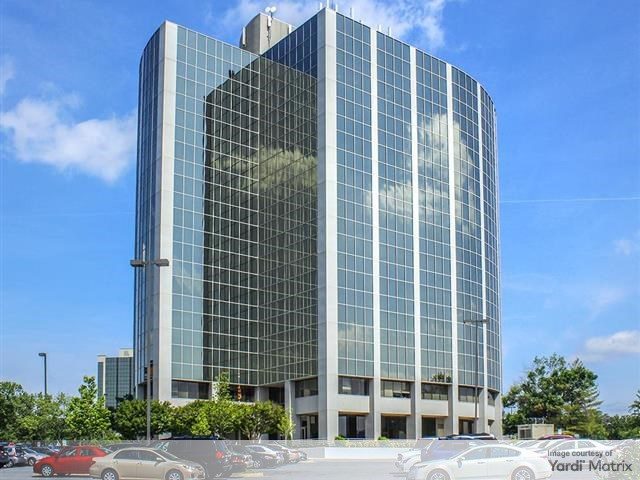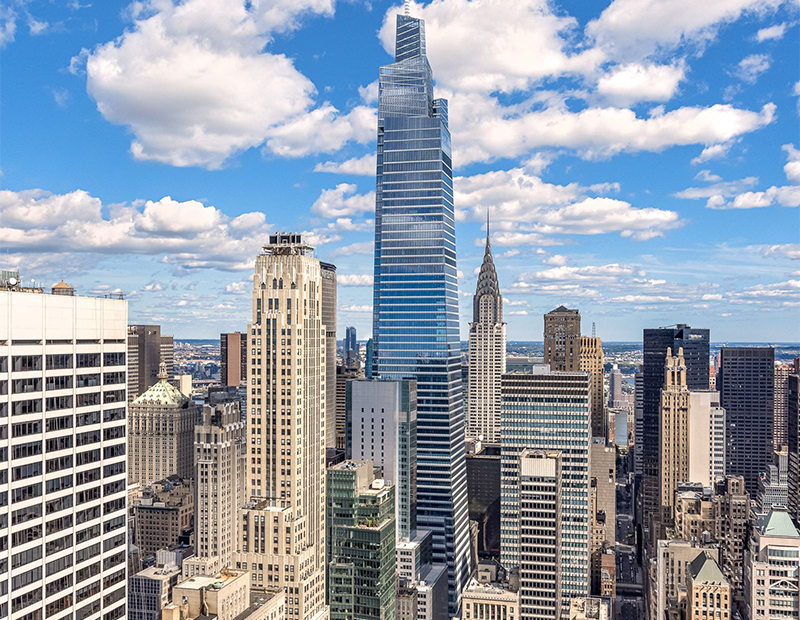BOMA New York & the Impact of Local Law 97
At a recent conference, experts discussed the impact of Local Law 97 and next steps in sustainability.

BOMA NY Energy Action Day: Alex Gulagaci, Lauren Moss, Christopher Cayten, Patrick Dolan, Michael Daschle and Lori Raphael. Image courtesy of BOMA NY
Following its yearly participation with Earth Day, the Building Owners & Managers Association of Greater New York hosted its annual event, Energy Action Day.
The panel, which featured Lauren Moss, chief sustainability officer at Vornado Realty Trust, Michael Daschle, senior vice president of sustainability at Brookfield Properties, and Alex Gulagaci, head of engineering at RXR, discussed the impact of Local Law 97. The panel was moderated by Christopher Cayten, managing director, CodeGreen Solutions.
Local Law 97 is being embraced by owners and tenants alike as a benefit—both to tenants’ health and well-being, and to property values. It mandates that most buildings over 25,000 square feet will be required to meet new energy efficiency and greenhouse gas emissions limits by 2024, with stricter limits coming into effect in 2030.
“Efficiency is now a core tenet of operating a commercial building, and it’s creating more valuable assets,” said Cayten. Gulagaci reinforced this point, stating that the industry had “evolved substantially” toward energy output efficiency during the past 18 months alone.
Moss noted Vornado’s commitment to carbon neutrality goals, citing the firm’s ambitious plans for the development of its PENN 1 and PENN 2 projects, slated for “carbon neutral delivery,” and an additional 70,000 square feet of tenant outdoor space. Daschle added that energy planning actions demands creativity among all stakeholders who were formerly “siloed” by their own agendas. Now, he said, “The effort has become how to market a lower cost solution, and marketing a property as energy efficient.” The challenge is “Educating all these groups and translating a project into a value proposition to each stakeholder.”
According to Moss, Vornado’s energy actions start with engaging tenants on energy usage at the earliest opportunity—and vice versa. “We’re seeing prospective tenants’ detailed RFPs, asking us what our energy goals are in order for them to evaluate our organization.” Gulagaci said, “At RXR, we have a scaled department solely dedicated to the actual tenant experience,” a collaborative dialog that creates “a drive to quality within the property.”
Cayten also asked the panelists about today’s evident nexus of “wellness being rolled into sustainability.” Gulagaci cited the example of the COVID-19 pandemic’s influence on tenant wellness and its inverse effect on energy usage. “The last two years of Covid shifted the dialog quite a bit with the focus to improve air quality with increased ventilation. This tends to have an adverse effect on energy efficiency since you’re utilizing more energy running infrastructure such as fans; but there is a sweet spot in this relationship.”
When asked about “projects you’re excited about,” Daschle cited Brookfield’s decarbonization of its property at 660 Fifth Avenue, an office tower that is being completely redeveloped by the firm. From the start he said, “it is 40 percent more energy efficient.” Gulagaci said that RXR is working on a pilot to implement augmented reality operations training, featuring digital goggles that allow trainees to simulate working on actual machinery.
The panel concluded with a discussion of a hot topic—electrification. Cayten said, “Indian Point provided 20 percent of New York City’s energy load. When it went offline, (that portion) of energy became 30 percent ‘dirtier.’ Local Law 97 was written) to push people toward electrification. Your utility bill may be three times higher than what it is today.”
Not only had the shutdown of Indian Point altered the energy efficiency landscape, Gulagaci added that the trend toward electrification raised concerns about the reliability of the distribution grid itself. He said, “The grid tends to be stressed during the summer months, and with increased electrification affecting our heating loads, this would potentially affect the winter months too.”
In his keynote address, Sen. Parker alluded to the panel’s electrification concerns. Speaking live on camera from Albany during the state’s budget negotiations, he confirmed reports that a new state law will ban natural gas hookups beginning in 2026 for most new buildings under seven stories and in 2029 for taller buildings.
Sen. Parker added that there was “a lot of work ahead of us,” but “all of us are working together” on the electrification of public and private development projects. “Gas isn’t the bad guy,” he said. “It’s reducing the carbon emissions from gas and methane. It’s a global challenge.”
Asked by an audience member whether the solution could be a drive toward the development of nuclear power plants in the state, the senator replied, “At present we have no offers for siting these plants.”







You must be logged in to post a comment.